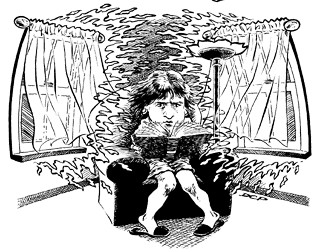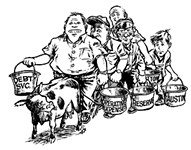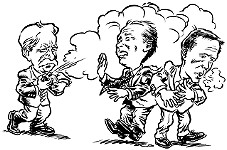Council Watch
Noises Off: Council Prepares Crackdown on Chronic Noise Nuisances
By Kevin Fullerton, Fri., Jan. 14, 2000

Here's a mixed-use development that neighborhoods could do without: For over a year, homeowner Mike Alexander has been complaining that the roar from condenser fans atop a two-story icemaker owned by his next-door neighbor, Junior's Beer and Wine on 29th Street, forces him to sleep with earplugs and interrupts conversations inside his home. Alexander called the police, but the decibel readings officers took on Alexander's property didn't violate the city's nuisance noise ordinance. So Alexander called the city's zoning office, asking the department to enforce decibel limits written into the Land Development Code. But staff there referred Alexander back to the police, who Alexander says blinked uncomprehendingly when he told them that city zoning limits machinery noise in residential areas to levels well below those allowed under the noise ordinance, whose chief use is to hold down disturbances from loud parties and music. Alexander discovered that no city official is empowered to investigate noise problems from motorized appliances. Meanwhile, Junior's owner John Zamora says he's been part of the neighborhood a lot longer than Alexander and can't afford to move or stop making ice, which he uses to chill beer kegs and sells to area bars and restaurants. Ironically, Zamora adds, the same city office Alexander has been complaining to, the Development Review and Inspection Department (DRID), made Zamora tear down an insulative shroud he built around the icemaker because they considered it an illegal extra structure on Zamora's lot.
The bitter feud that has arisen between Zamora and Alexander has prompted city officials to begin questioning whether better rules and enforcement are needed to control mechanical noise in a city that the present City Council hopes will grow more mixed and compact. A resolution submitted by Council Members Daryl Slusher and Bill Spelman for consideration today, Thursday, Jan. 13, calls for the Planning Commission and Austin Police Dept. to review whether Austin's noise regulations are giving everyone a good night's sleep.
Incessant Intrusions
Don't misunderstand. This is not another attempt to quiet downtown clubs, according to Slusher. The issue this time is recurring problems in residential neighborhoods, to which the city has been unable to respond -- not only from electric motors and fans, as in the case above, but from idling trucks and trash bin pickups, too. While complaints about these forms of noise pollution aren't the most common, they are the kinds of chronic intrusions that can make people the crankiest. Council members have noted that the decibel limits imposed by the nuisance noise ordinance (85 dB during the day, 80 dB at night) are well above those allowed by other major cities in Texas, and higher than the U.S. Housing and Urban Development Dept. permits in areas where it funds projects. HUD states that noise levels around 55-60 dB are most appropriate for residential areas, and that exposure to sound above 75 dB is unacceptable.
The Planning Commission has already approved an amendment to the city's Land Development Code, perhaps arriving before council next month, that would lower the limit for mechanical noise emanating from a property line from 70 dB to 60 dB. That's equivalent to the sound typically generated by a modern residential air conditioner, though old or cheaper ones may run louder. Commercial equipment, too, might not make the cut. Alexander says a sound engineer measured the condenser fan noise from Zamora's icemaker at just over 70 dB. Like the rule already posted in the code, however, the new noise limit would only apply to lots that are subject to other compatibility standards for single-family zoning. And, as Alexander discovered, zoning decibel limits currently have no teeth because DRID lacks the personnel to enforce them.
That may be changing, however. DRID principal planner Greg Guernsey says his department recently purchased decibel meters and hopes to train employees to use them within the next few months. Should the noise limit be lowered to 60 dB, Guernsey says, DRID inspectors wouldn't be out citing property owners for making noise above that level because the new rule wouldn't be retroactive. DRID personnel would be able to respond to complaints of noise above 70 dB, however, because that limit has been on the books for some time. Until more research is done, Slusher added, it's uncertain how new residential noise limits would affect the Eastside, traditionally one of the city's most noise-polluted zones.
Unintended Consequences
The Planning Commission has been tinkering with other amendments, too, including one that would ban refrigerated semi rigs from leaving their engines running while parked near homes overnight and another which would curtail the hours in which trash haulers could dump commercial bins. Currently, homeowners can do little if idling rigs are parked on their streets, because an engine rumble doesn't register above the decibel limit set by the noise ordinance. Planning Commissioner Robin Cravey says city staff is still working on drafts for these amendments.
"I think that one of the things people in neighborhoods complain most about is [noise] nuisances," says Cravey. "If we're going to live closer together, we're going to have to pay attention to that."
Slusher says he doubts that many homeowners or businesses would be affected by new noise controls, because most are responsible enough to take care of problems without being forced. But Slusher says he wants the rules made simple and easy to enforce, so residents with legitimate complaints can get some leverage on noise offenders. "It shouldn't be that government has to get involved, but unfortunately not everyone is reasonable about their noise, and it gets more important as the city gets denser," says Slusher.
Property management organizations and small business leaders contacted for this article said they'd be curious to know more about the details of the coming proposals, but said they sounded reasonable. Small Business United of Texas president David Pinkus said he didn't think most businesses located near homes use equipment that would cause noise problems, and if they do, they know they have to deal with the issue. "Small businesses want to be good neighbors because that's where their customers are," says Pinkus. "They don't want to antagonize anybody."
For his part, Zamora, who has owned Junior's Beer and Wine since 1990, says he always has been and wants to continue being a well-regarded member of the neighborhood. But the investments he has made in his ice business are too large for him to just shut down his icemaker or cut back its hours of operation, he says, especially during the summer. "The last thing I'm gonna do is move that machine, believe me," says Zamora. Noise issues didn't come up when DRID gave him the permit to install the machine, he says, and he contends his operation is perfectly legal to operate under the commercial zoning on his lot. Referring to the siege of complaints Alexander had lodged against his business, Zamora says it's become nothing short of harassment. He's "just using the city for his own means, to come after me," says Zamora, who says he's tried to reason with Alexander but the attitude is, "I just want you gone." Alexander, an engineer who designs microchips for Motorola, says he doesn't have to accommodate Zamora. The issue at hand is getting the city to enforce its noise codes, he says, so he doesn't have to put up with "the constant banging against [my] ears."
Bull Creek Battle
The latest battle of Bull Creek wound down rather noiselessly last Thursday, with a developer proposing 52 luxury homes on steep ridges overlooking the waterway getting most of what he wanted from the council in a compromise deal. Neighborhood leaders nodded tentative assent to the arrangement, which strikes a total of four houses from the developer's plan and prohibits impervious cover on the most severe inclines, but Northwest Austin Civic Association zoning officer Kay Kurio said she was slapping herself later.
"Now we're kind of like, 'What have we done?'" says Kurio. "I worked on this for two years to get only four houses taken off?"
"You're not thrilled, they're not thrilled," offered Spelman, approaching Kurio after the meeting. "It's the best we can get."
With the exception of Council Member Jackie Goodman, council seemed mostly resigned to the hilltop development, known as the Vista Ridge PUD, which neighbors say threatens Bull Creek water quality and intrudes on their pristine view of the ridgetops from Bull Creek Park. The original site plan, filed in 1985, could have covered the lots with as many as 67 townhomes, including some that could not have been accessed without filling in a gully. But the developer decided the market smiled more favorably on larger, freestanding homes, says the development team's lawyer, Terrence L. Irion, and didn't relish building the concrete detention tanks that layout would have required.
Under the proposal whipped up by Council Members Spelman and Beverly Griffith, which council would still have to grant final approval on at a later date, all but 13 of the homes will now drain into a wet pond, and the rest will be fitted with gravel-filled traps that catch runoff from rooftops. The council took away eight homes that posed access problems, but allowed the builder to scrunch four more in elsewhere. And the homes along the ridgeline visible from the park will be limited to one-story structures.
After the council approved her compromise, Griffith said that she felt that, although neighborhoods still had a valid petition in place against the development, "what we can achieve is enough satisfaction by all parties that that valid petition can be removed. That's the goal and I believe we're moving that way."
Kurio said that wasn't going to happen, however. "I don't think it was much of a negotiation," she said. "The cards were stacked against us on this one." Going into the negotiation, the Bull Creek Foundation had recommended that no more than 18 homes be built on the hills near Loop 360 and Lakewood Drive, and Kurio's group had hoped to compromise at 30.
On the other side, Mike Prewitt, representing the development team at the meeting, said he wasn't certain if it was possible from an engineering standpoint to lay out the houses the way the council plan proposes, so he too had reservations. Look for this one to come up again later this month.
This Week in Council
The council will likely decide whether to merely amend the Waterfront Overlay District ordinance to more accurately reflect the recommendations of the Town Lake Corridor Plan, or whether to shoot for the whole kit and kaboodle and rewrite the development guidelines altogether with the help of a consultant.
Upcoming: The next hearing on a proposed settlement with Gary Bradley, postponed last week because no new developments had occurred since the last time Bradley's Southwest Austin development plans came before council, is tentatively scheduled for Jan. 27. ![]()
Got something to say on the subject? Send a letter to the editor.








